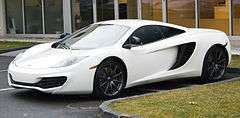Frank Stephenson
| Frank Stephenson | |
|---|---|
.jpg) Frank Stephenson (right) at the McLaren MP4-12C Launch for Lake Forest Sports Cars | |
| Born |
3 October 1959 Casablanca, Morocco |
| Nationality | American |
| Citizenship | British |
| Alma mater | Art Center College of Design |
| Occupation | Automobile Designer |
| Known for | design work at Mini, Fiat, Ferrari and McLaren |
Frank Stephenson (born 3 October 1959) is a British-American automobile designer widely known for his design work at Mini, Fiat, Alfa Romeo, Ferrari and McLaren.
In 2008, Autoblog called "one of most influential automotive designers of our time".[1][2]
Biography
Stephenson was born in Casablanca, Morocco (October 3, 1959) to an American father and a Spanish mother,[3] but currently holds a US and UK citizenship. Due to his father's job the family moved to a few different countries. They emigrated to Málaga, Spain where they lived for a short time while his father opened a car dealership.[4] Between 1970 and 1977 he lived in Istanbul, Turkey and then moved to Madrid where he finished high school.. After high school, Stephenson spent six years competing professionally in motocross. Since childhood he has been interested in motorcycles, a passion he's carried into adulthood.[5] This passion for all things automotive led him to study automotive design at the Art Center College of Design in Pasadena, California from 1983 to 1986. He speaks English, German, Italian and Spanish.[6][7]
Design career

Stephenson's design career spans several of Europe's best known automotive companies. He began at Ford's design studio in Cologne, Germany, where he penned some of the distinctive features of the Ford Escort RS Cosworth, in particular the large double rear spoiler.[6] He later moved to BMW where he spent 11 years, eventually leading to an appointment as Senior Designer. His redesign of the new Mini in 2001 led to the award-winning Mini Hatch, known generally as the Mini or Mini Cooper. This rebirth of the Mini launched a new generation of Mini marque models, and led to the Mini winning the prestigious North American Car of the Year award in 2003. Also while at BMW, Stephenson designed the BMW X5.[8][9]
In July 2002, Stephenson was appointed Director of Ferrari-Maserati Concept Design and Development. His work with Ferrari included the design of the Maserati MC12 and Ferrari F430. He also oversaw Pininfarina's work on the Maserati Quattroporte, Maserati GranTurismo and Ferrari 612 Scaglietti. Stephenson's success with Ferrari led to his appointment to head of the company's Fiat, Lancia, and Commercial Vehicle Styling Centre in Turin, Italy on February 22, 2005. He was tasked with rebuilding the struggling Fiat brand, where he directed the styling of the Punto, Bravo and translated Roberto Giolito's 2004 Fiat Trepiùno concept into the production 5002007. These three designs by Stephenson are credited with reviving Fiat sales and making the brand profitable again. In June 2007 he was made chief of Alfa Romeo Centro Stile where he replaced Wolfgang Egger, while Donato Coco took over his previous position at Fiat.
Stephenson left Fiat in April 2008 to become Design Director at McLaren Automotive, where he oversaw the design of the P1 and new range of McLarens.
Design style

Stephenson says that he looks everywhere for inspiration and is always sketching. He adds that he is "never bored", and that just walking down the street one can find inspiration from "things on the sidewalk, the type of tiles, the paintings on the signs, there's always something to inspire you". His McLaren office is full of toys. Stephenson says of this: "that's the nature of any designer, you'll find they have a toy shop around".[5] He also says that he looks to the animal kingdom for design, using what's called biomimicry. Having a deep passion for biology and evolution, he tries to "find the principles in nature that makes products do what they look like they do".[10]
Stephenson's process progresses from sketch pad, to computer graphics, to clay models, and finally test models. He says the advantage of working with clay is that you can feel the transitions and feel where there is too much surface or more surface needed. He suggests that you could almost design a car blind, because "you don't have to see it, you have to feel it, and by feeling it you feel if it's right or it's not right". [5]
References
- ↑ Noah Joseph (8 August 2008). "Frank Stephenson to direct McLaren design". autoblog. Retrieved 23 March 2012.
- ↑ Edward Loh (12 April 2011). "Frank Stephenson Gives Us His Exclusive Lowdown on the MP4-12C". Motor Trend. Retrieved 26 March 2012.
- ↑ Levent OZLER (23 February 2011). "Frank Stephenson: McLaren Automotive Design Director Speaking at Creative Barcode 360". Creative Barcode 360. Dexigner. Retrieved 25 March 2012.
- ↑ Paterick C. Paternie. MINI. ISBN 0-7603-1157-9.
- 1 2 3 "How to Build A Super Car". How to Build. Season 2. Episode 2. 22 November 2011. 8.30 minutes in. BBC. BBC Two.
- 1 2 Joshua Dowling; Sydney Morning Herald (8 September 2005). "Does this guy have the best job in the world?". Drive. Retrieved 3 April 2012.
- ↑ "Frank Stephenson to head Alfa Romeo styling centre". duemotori.com. Retrieved 2007-12-13.
- ↑ "Who's Where: Frank Stephenson appointed Director of Design for Alfa Romeo". cardesignnews.com. Retrieved 2007-12-13.
- ↑ Paterick C. Paternie. Mini. ISBN 0-7603-1157-9.
- ↑ "Interview with Frank Stephenson by Uygar Kilic". CarsAndLife.net. Retrieved 2012-01-27.